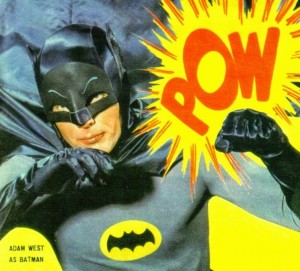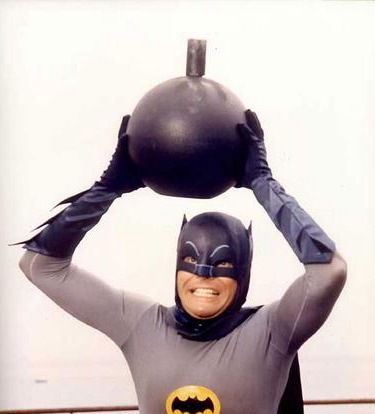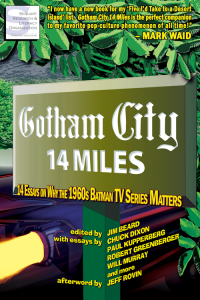 Where were you on Wednesday, January 12, 1966 at 7:29 p.m. EST? Me, I had my ass planted firmly in front of our TV set, warmed up and tuned to ABC, channel 7 in New York, ten and one half years old and breathlessly awaiting the debut of Batman, starring Adam West and Burt Ward.
Where were you on Wednesday, January 12, 1966 at 7:29 p.m. EST? Me, I had my ass planted firmly in front of our TV set, warmed up and tuned to ABC, channel 7 in New York, ten and one half years old and breathlessly awaiting the debut of Batman, starring Adam West and Burt Ward.
By 7:35 p.m., I was hooked. I was a kid, the very age, in fact, that kids like me formed attachments to our pop culture that usually follow us the rest of our lives. Batman would breath life back into DC Comics and the comic book industry in general, as well as help launch the mid-1960s Pop Art revolution.
But there was one thing I hated…
Excerpted from my essay for Gotham City: 14 Miles, 14 Essays on Why the 1960s Batman TV Series Matters, Edited by Jim Beard (Sequart Research and Literacy Organization, 2010):
“Some Days You Just Can’t Get Rid of a Bomb”: The Legacy of Batman
“Oh, my.” — Leonard Goldenson, ABC Television President, in response to the pitch for the Batman television show
When that first episode of Batman aired on January 12, 1966, I was ten and one-half years old. I was already a hardcore comic book reader and something of an accumulator, if not quite yet a collector, of as many comics as I could lay my hands on.
I was the audience for that show, eager, no dying to see another of my four-color heroes come to life on the TV screen, like The Adventures of Superman, the 104-episodes of which originally aired between 1952 and 1958 and continued on and on in daytime syndication during my childhood on New York’s WPIX-TV, Channel 11.
Pow! Zap ! Bam!
Yes, I recognized they were making fun of Batman, but so what? Grown-ups always made fun of comic books. My father, himself a reader of Doc Savage, the Shadow, Conan, and G-8 and His Battle Aces in the pages of the ten-cent pulp magazines of the 1930s, who brought home the 1960s Ace Books editions of the Tarzan novels with the gorgeous Frank Frazetta covers for his sons to read, who nurtured the creative instinct in the three of us, all of whom went into some sort of creative field, my father, who must have understood the appeal and certainly never discouraged our interest in comic books, nonetheless called the four-color pamphlets my older brother and I separately hoarded by the hundreds “Popeyes,” as in Popeye the Sailor Man, whose name became the noun for all comic books. “You left a pile of your Popeyes in the car,” he would say. “When you’re finished reading your Popeyes, would you take out the garbage?” Most adults just called them “funny books.”
And even in the ghetto of Pop Culture, comic books were the lowest of the kid stuff. Dangerous, even, if the doomsayers of the 1950s witch-hunts against the evils of comic books and their damaging effect on young minds were to be believed. And even if not dangerous, certainly disposable. To modern collectors in their Mylar bags sealed between slabs of plastic, the notion that a comic book was rolled up and stuck in the back pocket of an eleven year-olds jeans before and after being read (repeatedly, and by many kids) is sacrilegious, but that was exactly what we did. That issue of Spider-Man I romped around with in my back pocket in 1964 is worth hundreds, maybe thousands of dollars today, but back then, it was the center of my universe and, until I learned better a couple of years later, I ran around with it, or another one like it, rolled up in my pocket, where I could bring it out any time to read again. A copy of a Flash Annual from around the same period will forever carry the grit of New York’s Reis Park beach sand ground into its square-bound spine from that summer when it was the comic book I could not go anywhere without.
Pow! Zap! Bam!
Comics did not get respect before Batman and, aside from the recognition of comics during the run of the show, was no better off after than before. Respect was too much to ask of a funny book. The comics had been effectively neutered by the 1950s and were unlikely to feature anything capable of offending anybody (although there’s always someone to be offended by anything), but Senator Kefauver’s Congressional hearings into the link between comics, juvenile delinquency, and childhood emotional problems were only a decade in the past. These hearings were inconclusive and came up with no result other than the creation of the industry’s self-policing agency, the Comics Code Authority of America. The bad taste had nonetheless been left behind in everybody’s mouth and, in their memory of the hearings, comics had been officially stamped “garbage” by the U.S. government. What other proof did they need?
When it came to picking from this heap, Hollywood had not always approached it with such trepidation. In the 1940s, superheroes were successful on the radio (Superman on a three-times a week program on the Mutual Network) as well as on the big screen as serialized adventures, 10 or 12 15-minute weekly shorts, each with a cliffhanger ending to draw the kids back to the theater to see how the hero gets out of this one! Superman, Batman, Captain Marvel, Captain America, Blackhawk, and others from the comics were made into serials, while a series of Superman cartoon shorts produced by the Fleischer Studios (creators of Popeye and Betty Boop before the Man of Steel) for Paramount are still considered classics of animation. The Adventures of Superman starring George Reeves was, despite, the nostalgic chuckles it elicits today, a very faithful and, for the most part, straight adaptation of the Superman then in the comic books, scaled down from his skyscraper-lifting level of four-color power to a syndicated TV program’s budget. But, of course, the program was produced by DC Comics, its stories overseen by comic book editors-turned-producers Whitney Ellsworth and Mort Weisinger. They were company men playing with company toys and they were very careful not to break anything.
The one thing all of the above have in common is that they were created as and always intended to be for kids. Serials were shown on Saturday mornings, along with cartoons and other kid stuff. The Adventures of Superman radio program ran for 11-years in a late afternoon timeslot. The Adventures of Superman TV show, though its first two seasons, in black and white, are darker and more serious than the later color seasons, was always a kids show, right down to its sponsorship by Kellogg’s cereals.
Comics only started getting into on-screen trouble when someone decided to do a TV show for grown-ups without first getting over their embarrassment at what they were doing.
One always has to start from the premise that the people adapting comics to the screen, big or little, do not have any respect for the material, certainly not then and, comics overall public relations progress to the contrary, not still.
The people who make movies and television shows, who stage Broadway shows and publish literature are embarrassed by the source material, whether they will admit to it or not. They voice a love and admiration for this true American art form, but if what has hit the movie and television screens is the result of love, hate me, please. Even the best of them can not help metaphorically winking uncomfortably in acknowledgment of the source. The subtext may be Shakespearean in scope, but the brilliance is clad in primary colored spandex that overwhelms even the strongest message. (These same dramatists forgetting that Shakespeare himself was little more than a TV writer of his time, the legends and tales of the era serving as the source material for his plays, themselves pandering to the lowest common denominator in the cheap seats.)
But no message, as it turned out, would ever be stronger than this:
Pow! Zap! Bam!
It made the show. It was, the first time it hit the screen that January night in 1966, a self-announcing visual punch in the nose. It made mom and dad laugh. It was kitschy, campy, and in tune with the “pop art” movement popularized by such commercial artists as Andy Warhol and Roy Lichtenstein, both influenced by comic art, Lichtenstein, indeed, lifting, without credit or remuneration, entire panels from romance and war comics to recreate as such paintings as Drowning Girl and, more to the point of Pow! Zap! Bam!, Whaam! Marvel Comics, which, under the creative direction of Stan Lee and his co-writing artist cohorts like Jack Kirby, Steve Ditko, Don Heck, and others, had bumped up the level of comic book sophistication with continuing stories and heavy doses of soap opera elements inflicted on superheroes whose secret identities lead less-than-perfect lives, even went so far as to change its corner symbol identifying their titles as “Marvel Pop Art Productions” for four or five months during 1965, riding the wave of a trend their existence helped to set rolling.
“Pow! Zap! Bam!” was brilliant, an inclusive nod to the source material. Sound effects have long been a vital part of the vocabulary of comics. A picture of a fist in the vicinity of a chin is only half the story. The “WHAM!” of the knock-out punch or the “whoosh!” of the fist sailing past its target tells the rest. Hand-lettered onamonapia was straight out of the newspaper comic strips and comic books the chuckling adults had read as children. It was self-referential and precious and it was exactly the right touch of gentle mockery to catapult Batman into a full-blown, two-year long bona fide fad.
The only problem was, even after Batman was gone from the airwaves, it left “Pow! Zap! Bam!” behind.
To learn more or to order Gotham City, 14 Miles, click on the image below:
Tags: Batman, Batman TV series, DC Comics, Gotham City 14 Miles, Jim Beard, Sequart


I’m old enough to remember the Silver Age, when comics were still considered cheap, disposable entertainment for children. Today’s collectors probably can’t understand why people didn’t save them and store them carefully. I’m often surprised that so many comics have survived in even fair condition.
Fans of the Dark Knight hate the “Pow! Bam!” image, but camp and pop art were the fads in 1966. Each version of Batman-grim vigilante, straight superhero and detective, shlock sci-fi, New Look, campy comedy, grim vigilante again-was a product of its time.
Excerpt from a 2000 Larry King interview with Stan Lee:
STAN: A good comic book story has what any good adventure story has, except it’s illustrated. That’s all. But it has to have all the elements, good characterization, believable dialog and exciting situations that make you want to go to the next page.
LARRY: Believable dialogue? Zap, bam, whap?
STAN: Now those are sounds effects, you silly person. That’s not the dialogue.